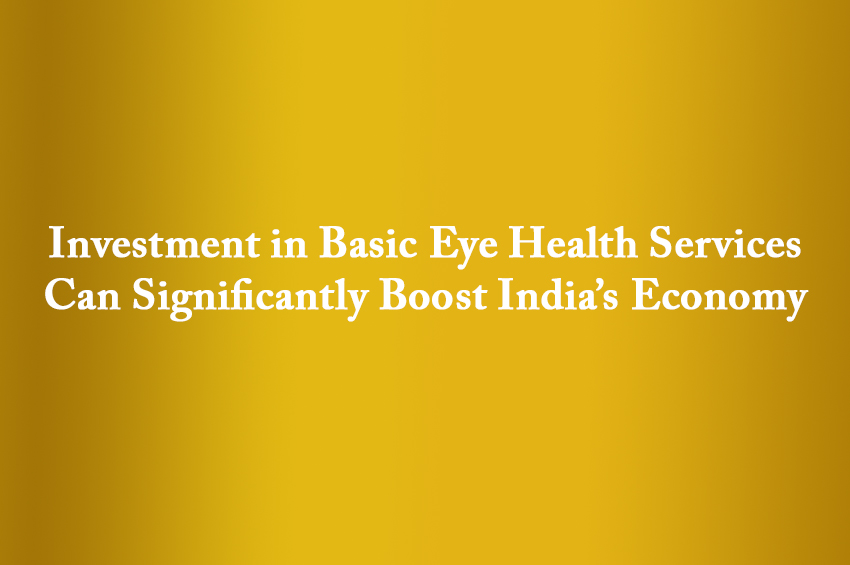Winning Bizness Economic Desk
An annual investment of Rs 22,100-crore in basic eye health services could unlock significant economic gains for India, a report by the International Agency for the Prevention of Blindness (IAPB), Seva Foundation and Fred Hollows Foundation stated.
Improved eye health-care delivery could generate Rs 3.6-lakh-crore benefits for the country with Rs 2.77-lakh-crore attributed to increased occupational productivity, Rs 78,700-crore to higher employment levels and Rs 40,800-crore to reduced care giving demands, it stated.
The report highlighted the fact that additionally, gains in education would equate to approximately 9,60,000 extra years of schooling.
Six key priorities for governments were identified in the report titled The Value of Vision.
The first three are early detection through community vison screenings, immediate provision of reading glasses where needed and expanding the eye health workforce.
The other three points are improving surgical productivity and quality, removing barriers such as cost and distance and enhancing cataract surgery outcomes through innovative training and technology.
Routine eye-checks remain among the simplest and most effective ways to protect sight and economic productivity alike. Simple low-cost interventions such as regular eye-tests in schools and the distribution of reading glasses could yield a return of Rs 16 for every Rupee invested, it pointed out.
Indo-UK Gems and Jewellery Trade Set to Double
The India-UK Comprehensive Economic & Trade Agreement (CETA) is set to double the country’s gem and jewellery exports to the United Kingdom (UK) to USD 2.5-billion over a three-year period.
It will also help create over 1,40,000 new jobs and strengthen the country’s position as a global leader in diamonds, gold, silver and lab-grown stones.
The Gem and Jewellery Export Promotion Council (GJEPC) which represents India’s gem and jewellery sector was present at the India-UK CEOs Forum, which was addressed by both the Prime Ministers of India and Britain.
The GJEPC Chairman Mr Kirit Bhansali said that the India-UK Free Trade Agreement is an important moment for the Indian gem and jewellery sector, unlocking growth opportunities and reinforcing India’s global leadership.
“With exports to the UK set to more than double to USD 2.5-billion within three-years, this partnership will not only boost trade but also generate over 1,40,000 new jobs, directly benefiting artisans, manufacturers and exporters across all key segments,” Mr Bhansali observed.
The FTA not only strengthens the country’s position as a world leader in diamonds, gold, silver and lab-grown stones but it also enables deeper market access and collaboration with UK retailers.
“We at GJEPC are committed to leveraging this historic agreement to drive innovation, employment and sustainable growth for the industry and the millions who depend on it,” Mr Bhansali said.
India on Track to Become a USD 5-trn Economy by 2027: Nitin Gadkari
The country is well on track to becoming a USD 5-trillion economy by 2027, Union Minister for Road Transport and Highways Mr Nitin Gadkari said, while addressing the 120th Annual Session of the PHD Chamber of Commerce and Industry (PHDCCI).
As per provisional estimates released for the year ending March 2025, the country’s nominal GDP stood at about USD 3.9-trillion.
Mr Gadkari said that when the present NDA government took office eleven years ago in 2014, the country’s automobile industry was ranked seventh globally with a valuation of Rs 14-lakh-crore.
Today, India is the third largest in the world, having overtaken Japan and its industry size stands at around of Rs 22-lakh-crore.
With advancements in research, innovation and adoption of alternative fuels, India could become the leading automobile manufacturing country globally within five years.
According to Mr Gadkari, the use of alternative fuels would help reduce crude oil imports worth Rs 22-lakh-crore annually.
Ethanol production policy reforms have increased the market price of maize, benefiting farmers, especially in Uttar Pradesh and Bihar, adding Rs 45,000-crore to their income, the Minister pointed out.
Infrastructure improvements have already reduced the country’s average logistics costs southward from 16 per cent of GDP, Mr Gadkari said. By end-this year, logistics costs will slide further to single-digits at around nine per cent.
According to the Minister, infrastructure development serves as the backbone of the economy, generating employment and government revenue while contributing significantly to GDP growth.
Mr Gadkari said that an investment of Rs 100 in national highways contributes Rs 31 to GDP.
Country’s Forex Reserves Fall to USD 699.96-bn for Week Ended October 3
India’s foreign exchange reserves slipped by USD 276-million to USD 699.96-billion in the week ended October 3, data from the country’s central bank—the Reserve Bank of India (RBI) showed.
A point to note here is that in the previous week, the reserves had slid sharply southward by USD 2.334-billion to USD 700.236-billion.
Foreign Currency Assets (FCAs) which constitute the bulk of the reserves, declined by USD 4.049-billiion to USD 577.708-billion.
Foreign Currency Assets are valued in US Dollar and include the impact of fluctuations in non-US currencies such as the Euro, Pound and Japanese Yen.
Gold reserves climbed up by USD 3.753-billion to USD 98.77-billion, providing some cushion to the overall reserves.
The Special Drawing Rights (SDRs) with the International Monetary Fund (IMF) moved northward by USD 25-million to USD 18.814-billion.
The country’s reserve position with the International Monetary Fund slid slightly by USD 4-million to USD 4.667-billion in the reporting week.
A point to note here is that the moderation in reserves comes amid a currency volatility and global market uncertainty.
Overall, the country’s foreign exchange reserves continue to be among the world’s largest, providing a buffer against external shocks and supporting the stability of the Rupee.
Royal Enfield, Suzuki Clock Best-Ever Monthly Sales in September
Two-wheeler major Royal Enfield has sold 1,24,328 motor-cycles, a 43 per cent vault as compared to the 86,978 units sold last year.
Of this, 1,13,573 units were sold in the country (domestically) while 10,755 motor-cycles were exported.
Here, the point to highlight is that the September number represents the highest monthly sales in Royal Enfield’s history.
The sales were boosted by strong demand across its popular mid-capacity motor-cycles.
Another two-wheeler manufacturer, Suzuki Motorcycle India also fared very well in September. The company clocked sales of 1,23,550 units which is 25 per cent more from the 99,185 units sold in the year-ago month.
The point to note here is that this is also the company’s best-ever monthly performance.
Domestic sales accounted for 1,05,886 units, zooming 37 per cent while exported slipped 19.4 per cent to 17,664 units from 21,922 units a year ago.
CAIT Estimates Diwali Sales at a Record Rs 4.75-lakh-cr
The Confederation of All India Traders (CAIT) has estimated this year’s Diwali festival sales to cross a record Rs 4.5-lakh-crore. This makes this festival season the strongest festive season in the past decade.
The Diwali trade spans a wide range of sectors such as food and groceries, fruits and dry fruits, pooja items, sweets and namkeen, electronic goods, textiles and garments, home décor items, cosmetics and personal care products and miscellaneous goods, among others.
CAIT’s secretary-general Mr Praveen Khandelwal said that GST tax reductions and Prime Minister Mr Modi’s call for Swadeshi and `Vocal for Local’ have proved to be immensely beneficial for the trading community.
The Diwali spirit and robust sales can be gauged from the bustling business big malls, shops and small traders are clocking.
Traders are witnessing strong footfalls alongside a tremendous consumer confidence.
What needs highlighting here is that Swadeshi goods have taken centre-stage with consumers consciously preferring indigenous products over imported ones.
While several families shop on modest budgets, others are spending thousands. This diversity of purchasing power underlines why Diwali remains the most vital trading period for the retail economy.
The ripple effect of Diwali is also energising the service sector as thousands of events, celebrations and community gatherings pan-India are creating huge business opportunities for hotels, restaurants, banquet halls, caterers, event managers, cab operators, decorators, musicians and artists.
“The (Diwali) festival is not just about lighting lamps—it’s about powering the entire economic eco-system of Bharat. Diwali is a festival of trade, tradition and trust,” Mr Khandelwal said.
“This Diwali, every Rupee spent in India strengthens an Indian enterprise,” he said, adding that this festival season would mark a turning point for the domestic retail economy.


